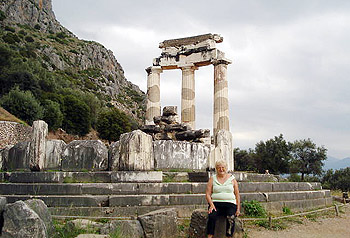
by W. Ruth Kozak
I set off from Athens on a morning when Zeus was tossing about his thunder bolts and a torrential rain filled the gutters with gushing streams ankle deep. I didn’t let that deter me and boarded the bus for Delphi, a three hour trip north into the mountains.
Delphi, located on the slopes of Mt. Parnassus, was the most important sacred sanctuary of ancient Greece, home of Apollo, god of light. No important decisions were made politically or personally in antiquity without first consulting the Delphic Oracle in Apollo’s sanctuary. The earliest finds date to the Neolithic times (4000 BC) when the first rituals took place in a cave on Parnassus.
Just as the ancient Greeks sought the oracle’s advice, each time I am in Greece I visit Delphi before I set off on any new adventures.
The rain had subsided by the time I arrived. My first goal was to hike down the mountain to the Castalian Spring. The spring is located several hundred metres downhill near the outskirts of the town in a gorge between the towering Phaidriades. It’s close to the goddess Ge’s sacred grove where once a sacred spring gushed from a cleft in the rocks. Pilgrims to Delphi bathed in the spring before proceeding to the Temple of Apollo.
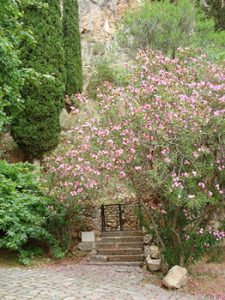 Due to the danger of falling rocks and restorations, the sacred grove is barred by a fence, but there’s a spring by the roadside burbling with fresh, cold water. Like past supplicants, I take a purifying wash and fill my canteen with drinking water for the hike down the hill. Across from the sacred grove a path leads to the gymnasium with its 189 meter running track, palaistra (training area) and baths. New excavations are in progress and the track has been restored. Farther down the road is the entrance to the Sanctuary of Athena Pronaia with its impressive circular Tholos (photo right). Then I proceed back uphill. The rain had refreshed and cooled the air so it was a pleasant though energetic hike back up the mountainside.
Due to the danger of falling rocks and restorations, the sacred grove is barred by a fence, but there’s a spring by the roadside burbling with fresh, cold water. Like past supplicants, I take a purifying wash and fill my canteen with drinking water for the hike down the hill. Across from the sacred grove a path leads to the gymnasium with its 189 meter running track, palaistra (training area) and baths. New excavations are in progress and the track has been restored. Farther down the road is the entrance to the Sanctuary of Athena Pronaia with its impressive circular Tholos (photo right). Then I proceed back uphill. The rain had refreshed and cooled the air so it was a pleasant though energetic hike back up the mountainside.
I enter the site, and follow the Sacred Way about 500 metres up the incline toward the entrance of the Temple of Apollo. In antiquity the Sacred Way was lined with splendid monuments erected by the city states of Greece, many of them dedicated in honour of victorious battles. Votive offerings donated by pilgrims brought Delphi great wealth. Once there were over 3,000 such structures within the sanctuary.
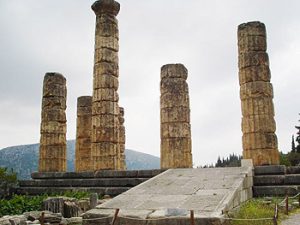 You sense the presence of the gods at Delphi. As I approach the great temple of Apollo, I imagine how majestic it must have been in ancient times. Just as I reached it, the sun breaks through the clouds, bathing the majestic Doric pillars in golden light (photo at left). It is here where the fabled Pythia sat on a tripod inhaling hallucinogenic vapours and interpreted the fates of the supplicants. I’m sure if the Pythia had been present that day she’d have portended good fortune.
You sense the presence of the gods at Delphi. As I approach the great temple of Apollo, I imagine how majestic it must have been in ancient times. Just as I reached it, the sun breaks through the clouds, bathing the majestic Doric pillars in golden light (photo at left). It is here where the fabled Pythia sat on a tripod inhaling hallucinogenic vapours and interpreted the fates of the supplicants. I’m sure if the Pythia had been present that day she’d have portended good fortune.
Continuing uphill, I climb a flight of steps and stop to catch my breath and quench my thirst in the shade near the curve of marble seats of the theatre. Here’s where the dramas of Euripides, Aeschylus and Sophocles were performed. Farther up the hill I reach the stadium with its well-preserved tiers of seats and a long oval running track. A thrill for dedicated joggers is to run a few laps around this ancient course.
As I trace my steps back down to the sacred precinct, just before the stout ochre pillars of the Sun God’s temple, I stop to place my hands on a curious carved stone called the omphalos. According to myth, two eagles met at this spot after being sent out by Zeus from the ends of the earth, thus accounting for the belief that Delphi is the “navel” of the world.
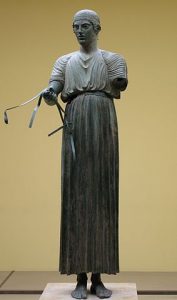 A trip to Delphi is never complete until I’ve visited the Charioteer, a bronze figure that once stood on the slope above the Temple of Apollo (photo at right). Commemorating a victorious race at the Pythian Games held in 478 BC, the statue is of a life-sized youth in a stance that appears to breathe with life, his life-like agate eyes are fringed with bronze threads for lashes, every muscle is taut as he holds his reins. The Charioteer survived a fourth century earthquake and is lodged in the museum, along with fragments of his chariot and horses.
A trip to Delphi is never complete until I’ve visited the Charioteer, a bronze figure that once stood on the slope above the Temple of Apollo (photo at right). Commemorating a victorious race at the Pythian Games held in 478 BC, the statue is of a life-sized youth in a stance that appears to breathe with life, his life-like agate eyes are fringed with bronze threads for lashes, every muscle is taut as he holds his reins. The Charioteer survived a fourth century earthquake and is lodged in the museum, along with fragments of his chariot and horses.
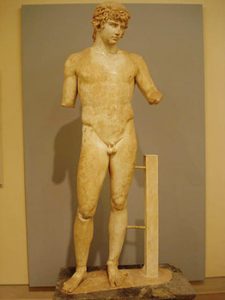 The new museum at Delphi is a wonder. It’s artistically constructed, the treasures tastefully displayed. It is one of the most important museums in Greece. Another of my favorites is the remarkably life-like sculpture of Antinous, beloved of Hadrian, who drowned in the Nile and was later deified (photo left). Here you will find the famous Hermes of Praxiteles.There is also copy of the omphalos and an impressive marble sphinx dating from 500 B.C., a gift from the Naxians. Also on display is the helmet of Miltiades, inscribed with “Miltiades dedicates to Zeus” It’s the same helmet worn by the famous general in the battle of Marathon where he defeated the Persians, and was offered to Zeus as a sign of gratitude.
The new museum at Delphi is a wonder. It’s artistically constructed, the treasures tastefully displayed. It is one of the most important museums in Greece. Another of my favorites is the remarkably life-like sculpture of Antinous, beloved of Hadrian, who drowned in the Nile and was later deified (photo left). Here you will find the famous Hermes of Praxiteles.There is also copy of the omphalos and an impressive marble sphinx dating from 500 B.C., a gift from the Naxians. Also on display is the helmet of Miltiades, inscribed with “Miltiades dedicates to Zeus” It’s the same helmet worn by the famous general in the battle of Marathon where he defeated the Persians, and was offered to Zeus as a sign of gratitude.
The town of Delphi itself is charming. It’s built on the edge of a deep, wide gorge with splendid scenery and a glimpse of the Gulf of Corinth in the distance. The remains of ancient Delphi are located within its boundaries.
That night I camped near the town. The moon was full, meteorites blazed across the sky, and I felt touched by magic. To me, Delphi is still a sacred sanctuary, a place to contemplate the mysteries of life, to appreciate the beauty of nature and marvel at human accomplishments. I can’t help but feel I have been in touch with the gods at Delphi, and I return to the bustle of Athens feeling blessed.
If You Go:
The sanctuary of Delphi is subsidized by the modest admission fees which include entry to the museum. It’s free on Sundays, closed on Mondays. Because it’s still considered a sacred site, no bathing suits, radios, recording equipment, refreshments or loud noises are allowed.
You can make it a day trip from Athens by bus. There are a number of hotels in Delphi but reservations are recommended in peak season.
Apollo Camping is located just at the outskirts of the town on the road to Itea. It’s equipped for caravans and tents and provides spaces under reed awnings for those who just want to roll out a sleeping bag. There’s a store on site and a swimming pool where you can refresh yourself after a hot day exploring the archaeological digs and museum. It’s walking distance from all the attractions and the bus stops nearby. Ask the bus driver to let you off at the campground, instead of in the town.
Tours to Delphi Now Available:
Delphi Full-Day Tour from Athens
Delphi Guided Walking Tour and Admission Ticket
Ancient Delphi Full-Day Tour from Athens
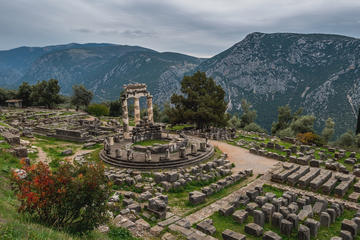
Delphi Out of The Ordinary Full Day Tour with Lunch
More Information:
Online City Guide: Olympia, Greece
About the author:
W. Ruth Kozak has been a historical fiction writer since her teens and a travel journalist for more than 15 years. What began as a personal journey to visit, then live in Greece, motivated by her life-long interest in ancient history, has now emerged into this travel ‘zine where other writers can share their experience of travel and life abroad. She also instructs classes on travel writing, creative and novel writing and memoirs. She has traveled extensively, often solo and always on a budget. Her website is www.ruthkozak.com
Photo credits:
Delphi Charioteer by RaminusFalcon / CC BY
All other photos are by W. Ruth Kozak




